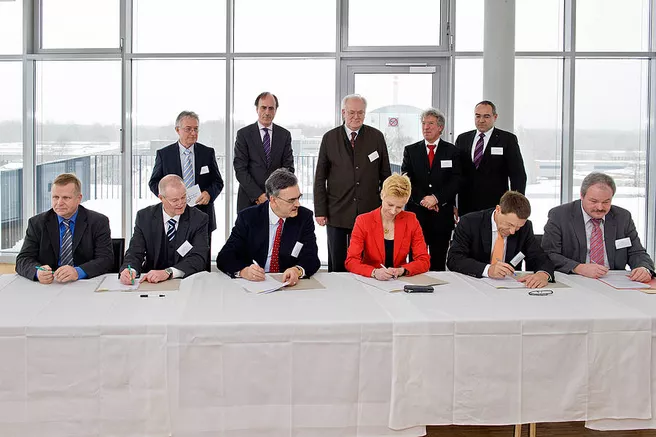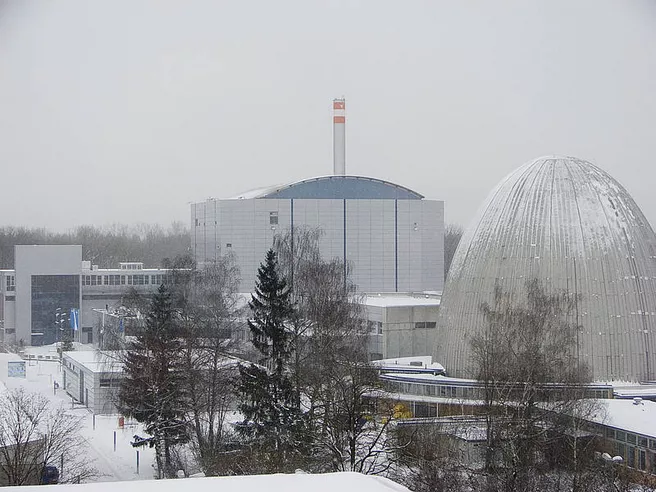The basis for these grants is the cooperation between the Technische Universität München (TUM) as operator of the FRM II and the Helmholtz Centers leading to joint scientific use of the neutron source.
The framework for this cooperation is set out in an administrative agreement between the German Federal Government and the State of Bavaria. The head of the Bavarian State Ministry of Science, Dr. Friedrich Wilhelm Rothenpieler, and the head of the Department for Basic Research at the BMBF, Dr. Karl Eugen Huthmacher, signed the agreement today in Garching. The cooperation contract itself was also signed today by TUM President Professor Wolfgang A. Herrmann, Member of the Board of the Research Center FZ Jülich Prof. Ulrich Krafft, Scientific Director of the Helmholtz Center Geesthacht, Prof. Wolfgang Kaysser, and Scientific Director of the Helmholtz Center Berlin Prof. Anke Pyzalla-Kaysser.
The contract stipulates that the German Federal Government will finance the scientific use of the FRM II via the Helmholtz Centers with 19.8 million euro per year. In addition, the three Helmholtz Centers under the auspices of the Center in Jülich will invest 10.52 million euro annually for neutron research. The contract will run over a period of ten years.
Neutrons are used to conduct research on the functions of complex materials such as proteins, superconductors and materials for energy storage. “The multifaceted capabilities of the Garching neutron source will attain a new quality through the cooperation between the TUM, as the responsible operator, and the three Helmholz Centers,” says TUM President Professor Wolfgang A. Hermann. “The foundation for this cooperation is the unrivaled performance spectrum of our neutron source, which attracts researchers from across the globe. A joint chair with the research center FZ Jülich in the field of neutron research would round things off perfectly.”
Pursuant to this agreement, the TU München and the three Helmholtz Centers will operate the FRM II jointly for scientific uses in the future. The Technische Universität München remains the sole operator of the neutron source itself. That is why the State of Bavaria will continue to fund reactor operation and research with 25 million euro annually.
FRM II Scientific Director Professor Winfried Petry is proud of the awarded grant: “The involvement of the Helmholtz Centers and the BMBF is the best evidence that we are already performing exceptionally well. The FRM II provides researchers with neutron beams of the utmost brilliance and its instruments lead the pack. This grant will provide us with the opportunity to exploit the potential of the neutron source even better in supporting top level German and international research.”
Concretely, the grant will be used to build new instruments, to upgrade existing instruments and to increase technical and scientific staff. New office and laboratory space will also need to be created for the additional personnel. Currently, 24 instruments at the FRM II are already at the disposal of guest scientists from around the world. The number of large-scale instruments will rise to over 30 in the near future. Measurement slots at the FRM II are in high demand. They are overbooked at more than twice the available capacity and are awarded via an application system based on scientific excellence and run by independent experts.
The cooperation contract is an extension to a cooperation agreement from 2004 with the Research Center FZ Jülich, which has set up its own branch at the FRM II. The Helmholtz Centers Jülich, Geesthacht and Berlin have been involved in the development and operation of large-scale scientific instruments at the neutron source in Garching. FZ Jülich is leading the way with five instruments in operation at the FRM II, and five more to follow. The Centers Geestacht and Berlin have two instruments and one instrument respectively. The Max Planck Gesellschaft also has two instruments. The TUM will operate 14 instruments, with a further instrument run jointly with the FZ Jülich. Furthermore, groups from seven other German universities are participating in the instrumentation. Their commitment will also be funded by the BMBF in the context of collective research.
More information:
press release of the Helmholtzzentrum Geesthacht

